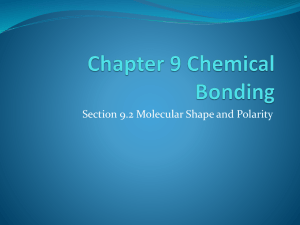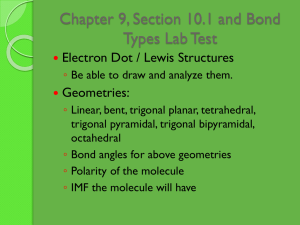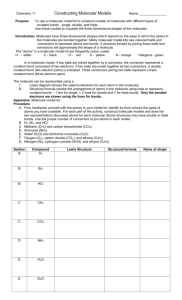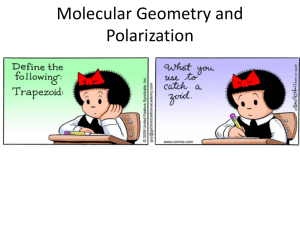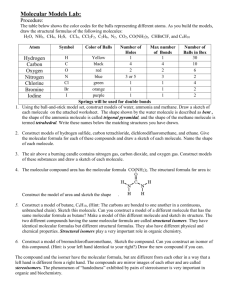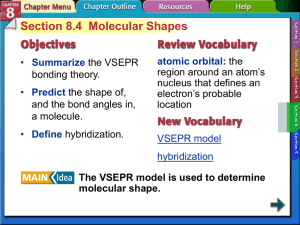linear atoms
advertisement
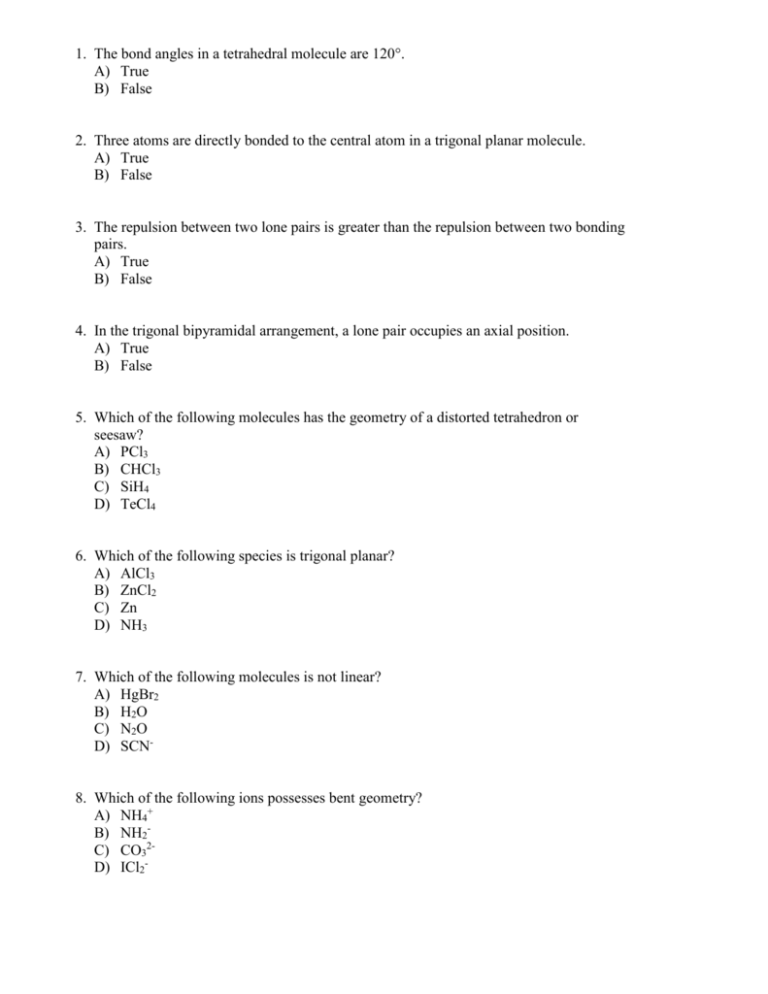
1. The bond angles in a tetrahedral molecule are 120°. A) True B) False 2. Three atoms are directly bonded to the central atom in a trigonal planar molecule. A) True B) False 3. The repulsion between two lone pairs is greater than the repulsion between two bonding pairs. A) True B) False 4. In the trigonal bipyramidal arrangement, a lone pair occupies an axial position. A) True B) False 5. Which of the following molecules has the geometry of a distorted tetrahedron or seesaw? A) PCl3 B) CHCl3 C) SiH4 D) TeCl4 6. Which of the following species is trigonal planar? A) AlCl3 B) ZnCl2 C) Zn D) NH3 7. Which of the following molecules is not linear? A) HgBr2 B) H2O C) N2O D) SCN- 8. Which of the following ions possesses bent geometry? A) NH4+ B) NH2C) CO32D) ICl2- 9. Which of the following species is tetrahedral? A) SiCl4 B) SeF4 C) XeF4 D) SF4 10. The Debye (D) is the unit for dipole moment. A) True B) False 11. A molecule, which possesses at least one bond moment, must possess a dipole moment. A) True B) False 12. An atom can have a permanent dipole moment. A) True B) False 13. Which of the following has the greatest dipole moment? A) H2O B) H2S C) H2Te D) H2Se 14. Which of the following has the smallest dipole moment? A) HBr B) HCl C) HI D) HF 15. Which of the following has the greatest dipole moment? A) H2O B) CBr4 C) H2S D) HF 16. Which of the following does not possess a dipole moment? A) OCS B) CS2 C) H2S D) IBr 17. Which of the molecules below has the greatest dipole moment? A) B) C) D) 18. It is impossible for an isolated atom to exist in the hybridized state. A) True B) False 19. Two 2p orbitals of an atom can hybridize to give two hybridized orbitals. A) True B) False 20. The angle between two sp hybrid orbitals on the same atom is 120°. A) True B) False 21. 1s and 2s orbitals on adjacent atoms can form a sigma bond. A) True B) False 22. What is the hybridization of Si in SiH4 and in H3Si-SiH3? A) sp2 B) sp3d C) sp3 D) sp 23. What is the change in hybridization (if any) of the Al atom in the following reaction: AlCl3 + Cl AlCl4 A) sp3 to sp2 B) sp2 to sp3 C) sp to sp3 D) none 24. Consider the reaction: BF3 + NH3 F3BNH3 Describe the changes in hybridization (if any) of the B and N atoms as a result of this reaction. A) B changes from sp2 to sp3, N changes from sp2 to sp3. B) B is unchanged; N changes from sp2 to sp3. C) Neither atom undergoes a change in hybridization. D) B changes from sp2 to sp3, N is unchanged. 25. In which of the following species is N not sp3 hybridized? A) NH3 B) H2NNH2 C) NO3 D) NH4+ 26. Which of the following molecules does not contain an sp2 hybridized carbon atom? A) H3C-CH3 B) H3C-CH=CH2 C) CH3-CH=CH-CH2OH D) CH3CH=O 27. In which of the following species is C not sp hybridized? A) CO B) HCOOH C) CO2 D) CN28. What is the hybridization state of the central N atom in the azide ion, N3-? (Arrangement of atoms: NNN.) A) sp3d B) sp2 C) sp3 D) sp 29. The allene molecule H2C=C=CH2 is linear (the three C atoms lie on a straight line). What are the hybridization states of the carbon atoms? A) sp2, sp, sp2 B) sp, sp, sp C) sp3, sp2, sp3 D) sp2, sp2, sp2 30. What is the hybridization of phosphorus in PF5? A) sp3d B) sp3 C) sp2 D) sp 31. How many sigma bonds and pi bonds are there in the molecule below? A) B) C) D) 4 sigma, 1 pi 5 sigma, 1 pi 4 sigma, 2 pi 1 sigma, 4 pi 32. How many pi bonds and sigma bonds are there in the tetracyanoethylene molecule? A) B) C) D) 4 sigma, 9 pi 9 sigma, 5 pi 4 sigma, 14 pi 9 sigma, 9 pi 33. Molecular orbital theory is another name for valence bond theory. A) True B) False 34. A bonding molecular orbital is a molecular orbital whose energy is lower than the atomic orbitals from which it was formed. A) True B) False 35. An antibonding molecular orbital is a molecular orbital whose energy is higher than the atomic orbitals from which it was formed. A) True B) False 36. In a pi molecular orbital, the electron density is concentrated symmetrically around a line between the two nuclei of the bonding atoms. A) True B) False 37. Bond order can be used for quantitative comparisons of the strengths of chemical bonds. A) True B) False 38. In molecular orbital theory, the oxygen molecule (O2) contains two unpaired electrons. A) True B) False 39. Arrange the following species in order of increasing stability: Li2, Li2+, Li2-. A) Li2+ = Li2 < Li2B) Li2 > Li2+ < Li2C) Li2- = Li2+ < Li2 D) Li2- < Li2+ < Li2 40. According to molecular orbital theory, B2 has a longer bond than B2-. A) True B) False 41. The carbide ion (C22-), which is formed by the loss of two protons from acetylene (C2H2), has a lower bond order than C2. A) True B) False 42. Which of the following species is diamagnetic? A) O2 B) O2+ C) O2D) O2243. In molecular orbital theory, the bond order of O2 is greater than that of O2+. A) True B) False 44. Molecular orbital theory predicts that F2 is more stable than F2+. A) True B) False 45. Delocalized molecular orbitals extend over three or more atoms. A) True B) False 46. Molecular orbital theory treats the benzene molecule in the same manner that the resonance concept does. A) True B) False 47. Both ethylene (C2H4) and benzene (C6H6) contain the C=C bond. The reactivity of ethylene is greater than that of benzene. For example, ethylene readily reacts with molecular bromine, whereas benzene is normally quite inert toward molecular bromine and many other compounds. Explain this difference in reactivity. A) Benzene is a liquid and is therefore less reactive than ethylene, which is a gas. B) Molecules of greater molecular weight are less reactive than molecules of lower molecular weight. C) The double bonds in benzene are delocalized and thus less reactive than an isolated double bond such as in ethylene. D) Molecules with larger numbers of double bonds are less reactive than molecules with fewer double bonds. 48. Explain why the symbol on the left is a better representation of benzene molecules than that on the right. A) The symbol on the left more accurately represents the shape of benzene than the one on the right. B) The symbol on the left better represents the delocalized nature of the double bonds of benzene. C) The symbol on the left better defines the number of pi electrons in benzene than the one on the right. D) The symbol on the left is easier to draw than the one on the right. 49. The molecule on the right has a more delocalized orbital than the molecule on the left. (Hint: Both molecules contain two benzene rings. In naphthalene, the two rings are fused together. In biphenyl, the two rings are joined by a single bond, around which the two rings can rotate.) A) True B) False 50. What is the state of hybridization of the central O atom in O3? A) sp B) sp3 C) sp2 D) sp3d 51. Which of the following species is not likely to have a tetrahedral shape? A) SiBr4 B) NF4+ C) SF4 D) BeCl42- 52. Which of the following has a dipole moment? A) PCl3 B) XeF4 C) PCl5 D) SF6 53. Mercury(II) bromide has bent geometry. A) True B) False 54. According to valence bond theory, a carbon-carbon double bond should be more stable than a silicon-silicon double bond. A) True B) False 55. Sulfur dichloride (SCl2) has bent geometry. A) True B) False 56. The sulfur atom in sulfur dichloride (SCl2) is sp2 hybridized. A) True B) False 57. Which of the following is non-planar in shape? A) BF3 B) ClO3C) H2O D) OF2 58. Which of the following molecules is linear? A) BeCl2 B) SnCl2 C) H2O2, D) SnH4 59. What is the hybridization state of arsenic in arsenic pentafluoride (AsF5)? A) sp B) sp2 C) sp3 D) sp3d 60. Which of the following species is nonpolar? A) SO3 B) PF3 C) F3SiH D) Br2CH2 61. Which of the following molecules is linear? A) H2O B) OF2 C) SnI2 D) CdBr2 62. The N2F2 molecule can exist in either of the following two forms: What is the hybridization of N in the molecule? A) sp B) sp2 C) sp3 D) sp3d 63. The geometry of the BeCl42 ion is pyramidal. A) True B) False 64. The CCC bonds in cyclopropane (C3H6), which has the shape of a triangle in which a C atom is bonded to two H atoms and two other C atoms at each corner, are strained relative to the CCC bonds in propane (C3H8). A) True B) False 65. The molecule shown below has a dipole moment. A) True B) False 66. So-called greenhouse gases, which contribute to global warming, have a dipole moment or can be bent or distorted into shapes that have a dipole moment. Which of the following is not a greenhouse gas? A) N2O B) CO C) N2 D) NO2 67. How many structures are possible for an octahedral molecule of the formula AX4Y2? A) five B) four C) two D) one 68. The compounds carbon tetrachloride (CCl4) and silicon tetrachloride (SiCl4) are similar in geometry and hybridization. However, CCl4 does not react with water but SiCl4 does. What is the explanation of the difference in their chemical reactivities? (Hint: The first step of the reaction is believed to be the addition of a water molecule to the Si atom in SiCl4.) A) Si has a d orbital to which water can add; C does not. B) SiCl4 is polar and CCl4 is not. C) Si and C are in different groups on the periodic table. D) The Si-H bond is shorter than the C-H bond. 69. The molecule B2 is diamagnetic. A) True B) False 70. The N atoms in the molecule below are in two hybridization states. What are they? a. sp, sp3d b. sp, sp3 c. sp, sp2 d. sp2, sp3 A) True B) False 71. The bond energy for Cl2 is greater than that for F2. A) True B) False 72. The molecular orbitals in the azide ion (N3-) are delocalized. (Arrangement of atoms is NNN.) A) True B) False 73. The ionic character of the bond in a diatomic molecule can be estimated by the formula ( ÷ ed) 100% where is the experimentally measured dipole moment (in C·m), e the electronic charge(in C), and d the bond length in meters. (The quantity ed is the hypothetical dipole moment for the case in which the transfer of an electron from the less electronegative to the more electronegative atom is complete.) Given that the dipole moment and bond length of HF are 1.92 D and 91.7 pm, respectively, calculate the percent ionic character of the molecule. A) 25.5% B) 43.6% C) 2.98% D) 56.4 % Answer Key 1. 2. 3. 4. 5. 6. 7. 8. 9. 10. 11. 12. 13. 14. 15. 16. 17. 18. 19. 20. 21. 22. 23. 24. 25. 26. 27. 28. 29. 30. 31. 32. 33. 34. 35. 36. 37. 38. 39. 40. 41. 42. 43. 44. 45. 46. 47. 48. 49. 50. B A A B D A B B A A B B A C D B A A B B A C B D C A B D A A B D B A A B B A C A B D B B A B C B A C 51. 52. 53. 54. 55. 56. 57. 58. 59. 60. 61. 62. 63. 64. 65. 66. 67. 68. 69. 70. 71. 72. 73. C A B A A B B A D A D B B A A C C A B B A A B Chapter 10 Chemical Bonding II Molecular Geometry and Hybridization of Atomic Orbitals Student: ___________________________________________________________________________ 1. According to the VSEPR theory, the shape of the SO3 molecule is A. B. C. D. E. 2. The shape of the SF4 molecule is A. B. C. D. E. 3. linear bent trigonal planar trigonal pyramidal tetrahedral According to VSEPR theory, the shape of the PH3 molecule is best described as A. B. C. D. E. 5. tetrahedral. trigonal pyramidal. trigonal planar. square planar. distorted tetrahedron (seesaw). Use VSEPR theory to predict the shape of the PCl3 molecule. A. B. C. D. E. 4. pyramidal. tetrahedral. trigonal planar. distorted tetrahedron (seesaw). square planar. linear. trigonal planar. tetrahedral. bent. trigonal pyramidal. The shape of the CS2 molecule is best described as A. B. C. D. E. linear. trigonal planar. tetrahedral. bent. trigonal pyramidal. 6. The shape of the ClF3 molecule is best described as A. B. C. D. E. 7. According to the VSEPR theory, the molecular shape of the carbonate ion, CO32 -, is A. B. C. D. E. 8. square planar. tetrahedral. pyramidal. trigonal planar. octahedral. According to the VSEPR theory, the molecular shape of beryllium chloride is A. B. C. D. E. 9. distorted tetrahedron. trigonal planar. tetrahedral. T-shaped. trigonal pyramidal. linear. trigonal planar. bent. tetrahedral. trigonal pyramidal. According to the VSEPR theory, the molecular shape of SiCl4 is A. B. C. D. E. linear. trigonal planar. bent. tetrahedral. trigonal pyramidal. 10. According to the VSEPR theory, the molecular shape of boron trichloride is A. B. C. D. E. linear. trigonal planar. bent. tetrahedral. trigonal pyramidal. 11. According to the VSEPR theory, the molecular shape of ammonia is A. B. C. D. E. linear. trigonal planar. bent. tetrahedral. trigonal pyramidal. 12. According to the VSEPR theory, which one of the following species should be linear? A. B. C. D. E. H2S HCN BF3 H2CO SO2 13. According to VSEPR theory, which one of the following molecules should have a shape that is trigonal bipyramidal? A. B. C. D. E. SF4 XeF4 NF3 SF6 PF5 14. According to VSEPR theory, which one of the following molecules should be nonlinear? A. B. C. D. E. CO2 C2H2 SO2 BeCl2 KrF2 15. According to VSEPR theory, which one of the following molecules should have a bent shape? A. B. C. D. E. Cl2O CO2 HCN CCl4 none of them 16. Which one of the following molecules has tetrahedral geometry? A. B. C. D. E. XeF4 BF3 AsF5 CF4 NH3 17. According to VSEPR theory, which one of the following molecules has tetrahedral geometry? A. B. C. D. E. NH3 CCl4 CO2 SF4 PCl5 18. Predict the geometry around the central atom in PO43-. A. B. C. D. E. trigonal planar trigonal pyramidal tetrahedral trigonal bipyramidal octahedral 19. Predict the geometry around the central atom in SO42-. A. B. C. D. E. trigonal planar trigonal pyramidal tetrahedral trigonal bipyramidal octahedral 20. Predict the geometry around the central atom in XeO4. A. B. C. D. E. trigonal planar trigonal pyramidal tetrahedral trigonal bipyramidal octahedral 21. Which of the following substances is/are bent? (i) H2S A. B. C. D. E. (ii). CO2 (iii) ClNO (iv) NH2- (v) O3 only (iii) only (i) and (v) only (i), (iii), and (v) all are bent except for (iv) all are bent except for (ii) 22. Which of the following substance is/are planar? (i) SO3 A. B. C. D. E. (ii) SO32- only (i) and (ii) only (i), (iii), and (v) only (iv) all are planar except (iv) all are planar except (ii) (iii) NO3- (iv) PF3 (v) BF3 23. The bond angle in Cl2O is expected to be approximately A. B. C. D. E. 90. 109.5. 120. 145. 180. 24. The F-S-F bond angles in SF6 are A. B. C. D. E. 90 and 180. 109.5. 120. 180. 90 and 120. 25. The F-Cl-F bond angles in ClF3 are expected to be approximately A. B. C. D. E. 90 only. 109.5 only. 120 only. 180 only. 90 and 180. 26. According to the VSEPR theory, the actual F-As-F bond angles in the AsF4- ion are predicted to be A. B. C. D. E. 109.5. 90 and 120. 180. < 109.5. < 90 and < 120. 27. The C-N-O bond angle in nitromethane, CH3NO2, is expected to by approximately A. B. C. D. E. 60. 90. 109.5. 120. 180. 28. Which one of the following molecules is nonpolar? A. B. C. D. E. NH3 OF2 CH3Cl H2O BeCl2 29. Complete this sentence: The PCl5 molecule has A. B. C. D. nonpolar bonds, and is a nonpolar molecule. nonpolar bonds, but is a polar molecule. polar bonds, and is a polar molecule. polar bonds, but is a nonpolar molecule. 30. Which one of the following molecules has a non-zero dipole moment? A. B. C. D. E. BeCl2 Br2 BF3 IBr CO2 31. Which one of the following molecules has a zero dipole moment? A. B. C. D. E. CO CH2Cl2 SO3 SO2 NH3 32. Which one of the following molecules is polar? A. B. C. D. E. PBr5 CCl4 BrF5 XeF2 XeF4 33. Predict the molecular geometry and polarity of the SO2 molecule. A. B. C. D. E. linear, polar linear, nonpolar bent, polar bent, nonpolar none of these 34. Predict the geometry and polarity of the CS2 molecule. A. B. C. D. E. linear, polar linear, nonpolar tetrahedral, nonpolar bent, nonpolar bent, polar 35. Which of the following species has the largest dipole moment (i.e., is the most polar)? A. B. C. D. E. CH4 CH3Br CH2Br2 CHBr3 CBr4 36. Indicate the type of hybrid orbitals used by the central atom in PCl3. A. B. C. D. E. sp sp2 sp3 sp3d sp3d2 37. Indicate the type of hybrid orbitals used by the central atom in CCl4. A. B. C. D. E. sp sp2 sp3 sp3d sp3d2 38. Indicate the type of hybrid orbitals used by the central atom in SF6. A. B. C. D. E. sp sp2 sp3 sp3d sp3d2 39. What is the hybridization of the As atom in the AsF5 molecule? A. B. C. D. E. sp sp2 sp3 sp3d sp3d2 40. What is the hybridization on the central atom in NO3- ? A. B. C. D. E. sp sp2 sp3 sp3d sp3d2 41. In which one of the following molecules is the central atom sp2 hybridized? A. B. C. D. E. SO2 N2O BeCl2 NF3 PF5 42. What is the hybridization of As in the AsF4- ion? A. B. C. D. E. sp sp2 sp3 sp3d sp3d2 43. What is the hybridization of the central atom in ClO3- ? A. B. C. D. E. sp sp2 sp3 sp3d sp3d2 44. The hybridization of the central nitrogen atom in the molecule N2O is A. B. C. D. E. sp. sp2. sp3. sp3d. sp3d2. 45. If a triatomic molecule is linear, then the hybridization of the central atom will be A. B. C. D. E. sp. sp2. sp or sp3. sp or sp3d. sp2 or sp3d2. 46. In which of these molecules do the two nitrogen atoms have different hybridizations? A. B. C. D. E. NH4NO3 N2H4 N2O4 N2O5 none of these 47. Which of the following molecules have the same geometries? A. B. C. D. NH2- and H2O NH2- and BeH2 H2O and BeH2 NH2-, H2O, and BeH2 48. Which of the following molecules have the same geometries? A. B. C. D. SF4 and CH4 CO2 and H2O CO2 and BeH2 N2O and NO2 49. The number of pi bonds in the molecule below is A. B. C. D. E. 1. 2. 3. 5. 9. 50. The number of pi bonds in the molecule below is A. B. C. D. E. 2. 4. 6. 10. 15. 51. The number of pi bonds in the oxalate ion (C2O42-) is A. B. C. D. E. 1. 2. 3. 4. 5. 52. Consider the species Cl2+, Cl2, and Cl2-. Which of these species will be paramagnetic? A. B. C. D. E. Only Cl2 Cl2+ and Cl2 Cl2 and Cl2Cl2+ and Cl2All three are paramagnetic. 53. Consider the species N2-, N2, and N2+. Which of these species will be paramagnetic? A. B. C. D. E. N2 and N2N2+ and N2 N2+ and N2Only N2none are paramagnetic 54. In which of the following would the bonding be strengthened with the addition of an electron to form the negative molecular ion? A. B. C. D. E. N2 O2 F2 all of these none of these 55. In which of the following would the bonding be strengthened with the addition of an electron to form the negative molecular ion? A. B. C. D. E. C2 O2 N2 all of these none of these 56. In which of the following would the bonding be weakened with the addition of an electron to form the negative molecular ion? A. B. C. D. E. B2 C2 N2 all of these none of these 57. In which of the following would the bonding be weakened with the addition of an electron to form the negative molecular ion? A. B. C. D. E. N2 O2 F2 all of these none of these 58. Which of the following is not true of molecular orbitals? A. B. C. D. E. The number of molecular orbitals formed is always equal to the number of atomic orbitals combined. A molecular orbital can accommodate up to two electrons. When electrons are added to orbitals of the same energy, the most stable arrangement is predicted by Hund's rule. Low-energy molecular orbitals fill before high-energy molecular orbitals fill. For any substance, the number of electrons in molecular orbitals is equal to the sum of all the valence electrons on the bonding atoms. 59. The electrons in the delocalized molecular orbitals of benzene (C6H6) A. B. C. D. E. are confined between two adjacent bonding atoms. are free to move around the six-membered ring. form the electron pairs in the C-H bonds of the compound. are unevenly distributed through the molecule. are responsible for the fact that the bonds between three pairs of carbon atoms in the ring are longer and stronger than the bonds between the other three pairs of carbon atoms. 60. Which of the following correctly lists species in order of increasing bond length? A. B. C. D. E. O2 < O2+ < O2O2- < O2 < O2+ O2+ < O2 < O2O2- < O2+ < O2 O2+ < O2- < O2 61. Which of the following correctly lists species in order of increasing bond length? A. B. C. D. E. C2- < C2 < C2+ C2 < C2+ < C2C2- < C2+ < C2 C2+ < C2 < C2C2+ < C2- < C2 62. Which of the following correctly lists species in order of increasing bond order? A. B. C. D. E. C2 < Li2 < Be2 < N2 Be2 < Li2 < C2 < N2 N2 < Be2 < Li2 < C2 N2 < C2 < Li2 < Be2 Be2 < C2 < N2 < Li2 63. Use VSEPR theory to predict the molecular geometry of H3O+ (hydronium ion). 64. Use VSEPR theory to predict the molecular geometry of CO32-. 65. Use VSEPR theory to predict the molecular geometry of SF4 (sulfur tetrafluoride). 66. Use VSEPR theory to explain why the water molecule is bent, rather than linear. 67. Using periodic trends, arrange the following molecules in order of increasing dipole moment: NH3, PH3, AsH3. 68. Explain why CO2 is nonpolar, but OCS is polar. 69. The N - N - H bond angles in hydrazine N2H4 are 112. What is the hybridization of the nitrogen orbitals predicted by valence bond theory? 70. Indicate the number of -bonds in C2H4. 71. Indicate the number of -bonds in C2H6. 72. Indicate the number of -bonds in N2H2. 73. According to the VSEPR theory, the geometrical structure of PF5 is 74. Draw a Lewis structure for PF5 that shows the correct atom arrangement predicted by the VSEPR theory. 75. The VSEPR theory predicts that the F - P - F bond angles in PF5 are 76. According to the VSEPR theory, will the molecule PF5 be polar or nonpolar? 77. How does the geometrical structure of PF5 differ from that of IF5? 78. Ozone (O3) is an allotropic form of oxygen. Use VSEPR theory to predict the shape of the ozone molecule. 79. Which should have the longer bond, B2 or B2- ? 80. Which should have the longer bond, O2 or O2+? 81. Complete the following table. 82. In benzene (C6H6), what is the hybridization of each carbon atom? 83. Which of the following molecules should be polar? a. CH3OH b. H2O c. CH3OCH3 84. For the molecule below, what is the hybridization for each of the carbon atoms in this structure? (Note: Hydrogen atoms are not shown.) 85. According to the VSEPR theory, all of the electron pair-electron pair repulsions about the central atom in PCl3 are of equal magnitude. True False 86. The BrF5 molecule has polar bonds and has a net dipole moment. True False 87. Pi bonds are covalent bonds in which the electron density is concentrated above and below the plane of the nuclei of the bonding atoms. True False 88. The hybridization of B in the BF3 molecule is sp3. True False 89. A bonding molecular orbital is of lower energy (more stable) than the atomic orbitals from which it was formed. True False 90. A homonuclear diatomic molecule is a molecule composed of three atoms of the same element. True False 91. A species with a bond order of 1/2 may be stable. True False 92. More energy is required to break a bond with an order of 3/2 than is required to break a bond of order 2. True False Chapter 10 Chemical Bonding II Molecular Geometry and Hybridization of Atomic Orbitals Key 1.C 2.E 3.D 4.E 5.A 6.D 7.D 8.A 9.D 10.B 11.E 12.B 13.E 14.C 15.A 16.D 17.B 18.C 19.C 20.C 21.E 22.B 23.B 24.A 25.E Page 1 26.E 27.D 28.E 29.D 30.D 31.C 32.C 33.C 34.B 35.D 36.C 37.C 38.E 39.D 40.B 41.A 42.D 43.C 44.A 45.D 46.A 47.A 48.C 49.C 50.B 51.B 52.D 53.C 54.E 55.A 56.C Page 2 57.D 58.E 59.B 60.C 61.A 62.B 63.trigonal pyramidal 64.trigonal planar 65.distorted tetrahedron (seesaw) 66.About the central oxygen atom are two lone pairs and two bonding pairs, with these four electron pairs adopting an (approximately) tetrahedral geometry in order to minimize the electron-electron repulsion. The molecular geometry, reflecting only the orientation of the bonding pairs, is thus bent. 67.AsH3 < PH3 < NH3 68.In CO2 the two bond moments point in opposite directions and are of equal magnitude. Therefore, they cancel. In OCS, even though the two bond moments point in opposite directions, they are not of the same magnitude and so do not cancel. 69.sp3 70.1 71.0 72.1 73.trigonal bipyramidal. 74. 75.90 and 120. 76.nonpolar 77.PF5 is trigonal bipyramidal, whereas IF5 is square pyramidal 78.Bent 79.B2 80.O2 Page 3 81. 82.sp2 83.all of these are polar molecules. 84. C1 = sp3, C2 = sp3, C3 = sp2, C4 = sp2, C5 = sp3, C6 = sp2, C7 = sp3 85.FALSE 86.TRUE 87.TRUE 88.FALSE 89.TRUE 90.FALSE 91.TRUE 92.FALSE Page 4
